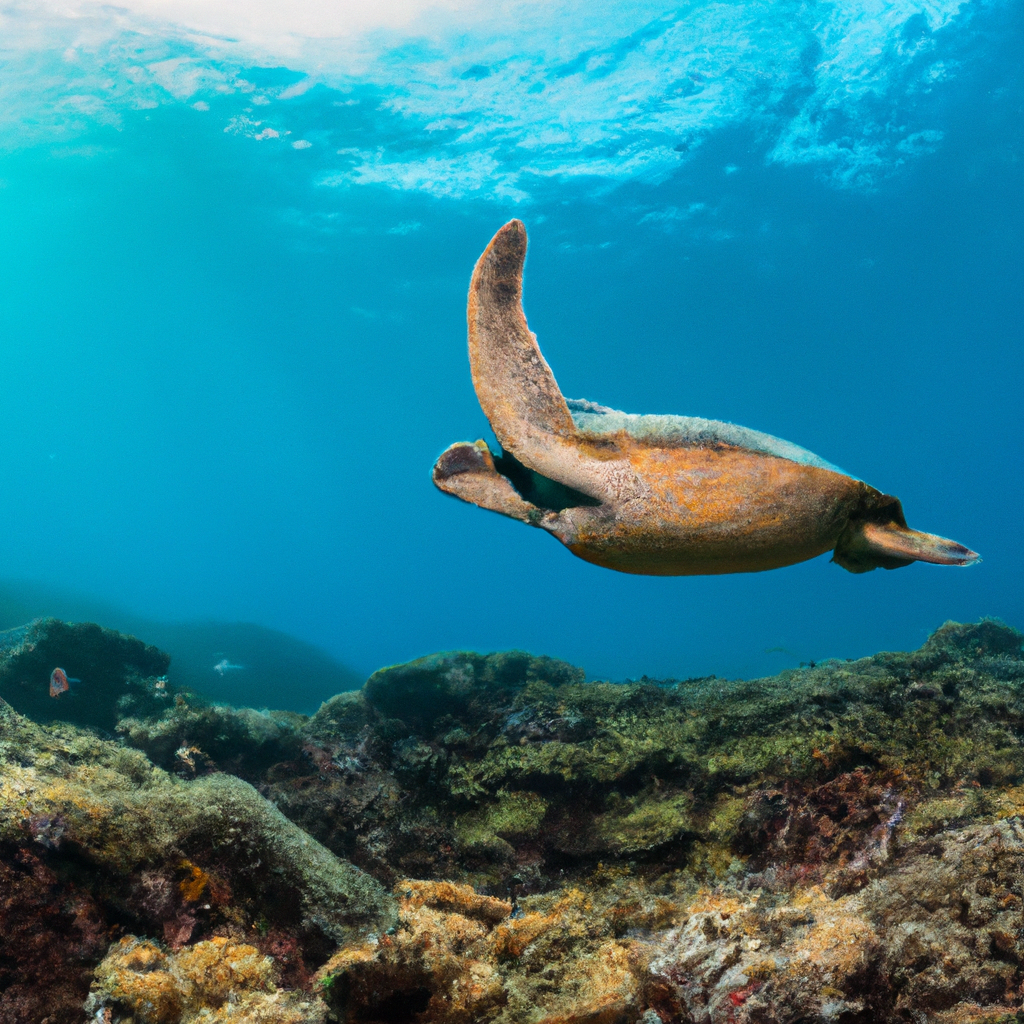Imagine a world where the enchanting beauty of sea turtles, or “tortugas” in Spanish, is threatened by the pressing issue of climate change. In this fascinating article, we explore the intricate relationship between these magnificent creatures and the changing climate. From the nesting habits to their long-distance migrations, join us as we unravel the implications of climate change on the survival of sea turtles and learn about the crucial role they play in our oceans’ ecosystems. Get ready to embark on a captivating journey, where science and nature join forces to shed light on the profound impact of climate change on our beloved tortugas.

Overview of Tortugas
Description of tortugas
Tortugas, or turtles, are reptiles that are part of the Chelonioidea family. They are characterized by their hard, protective shells which house their bodies and provide them with incredible resilience. There are several species of tortugas, including the green turtle, hawksbill turtle, loggerhead turtle, leatherback turtle, and olive ridley turtle. These majestic creatures have been around for millions of years and are found in various marine habitats around the world.
Importance of tortugas in the ecosystem
Tortugas play a vital role in maintaining the health and balance of marine ecosystems. They are known as ecosystem engineers, as they contribute to the structure and function of coastal habitats. Tortugas help control population levels of their prey species, such as jellyfish and sea sponges, ensuring a balanced ecosystem. Additionally, their feeding habits help maintain the health of seagrass beds and coral reefs, which are important habitats for diverse marine life.
Threats to tortugas
Unfortunately, tortugas face numerous threats that put their survival at risk. Habitat destruction, pollution, illegal hunting, and accidental capture in fishing gear are some of the significant challenges they face. Additionally, climate change poses a significant threat to their survival. Rising temperatures, increasing sea levels, ocean acidification, and changes in ocean currents all have profound impacts on tortugas and their ability to adapt to changing environments.
Significance of studying tortugas in relation to climate change
Studying tortugas and their response to climate change is essential for several reasons. Firstly, tortugas are considered keystone species, meaning their presence or absence has a disproportionate impact on the overall ecosystem. By studying tortugas, we gain insights into the broader implications of climate change on marine habitats and the species that depend on them. Secondly, tortugas are long-lived creatures, which makes them excellent indicators of environmental conditions and allows researchers to monitor changes over time. Finally, understanding how tortugas are affected by climate change can help inform conservation strategies and protect these magnificent creatures for future generations.
Effects of Climate Change on Tortugas
Rising sea levels and nesting habitats
One of the most significant threats climate change poses to tortugas is the rising sea levels, which directly impacts their nesting habitats. Many turtle species, such as the leatherback turtle and loggerhead turtle, rely on sandy beaches to lay their eggs. As sea levels rise, these nesting sites are at risk of erosion and inundation, leading to a decrease in suitable nesting areas for tortugas. This can result in reduced nesting success and population decline.
Increasing temperatures and sex ratios
Another effect of climate change on tortugas is the increasing temperatures, which can influence the sex ratios of hatchlings. The sex of turtle hatchlings is determined by the incubation temperature of the eggs. Warmer temperatures tend to produce more female hatchlings, while cooler temperatures result in more males. As climate change leads to higher temperatures, there is a concern that the skewed sex ratios could negatively impact the reproductive success of turtle populations.
Ocean acidification and impacts on food sources
Ocean acidification, caused by the absorption of excess carbon dioxide from the atmosphere, is a significant consequence of climate change. This phenomenon can have detrimental effects on the food sources of tortugas. For example, the acidification of the oceans can impair the growth and calcification of the coral reefs, which are important habitats and food sources for many turtle species. The decline in healthy coral reefs can disrupt the food chain and lead to food scarcity for tortugas.
Changes in ocean currents and migration patterns
Climate change can also alter ocean currents and disrupt the natural migration patterns of tortugas. These currents play a crucial role in the dispersal of hatchlings, foraging behavior, and their ability to find suitable habitats. Changes in ocean currents can result in the displacement of turtle populations, leading to increased vulnerability and reduced access to crucial resources. Understanding these changes in migration patterns is essential for effective conservation strategies.
Mitigation and Adaptation Strategies
Conservation efforts and protected areas for nesting grounds
To mitigate the adverse effects of climate change on tortugas, conservation efforts play a vital role. Creating and maintaining protected areas for nesting grounds are crucial steps in preserving these habitats. By designating certain beaches as protected areas, authorities can enforce regulations to limit human disturbance, reduce pollution, and prevent habitat destruction. Protecting nesting grounds ensures that tortugas have a safe space to lay their eggs, increasing the chances of successful nesting.
Artificial shading and sand replenishment
Rising temperatures, exacerbated by climate change, can have detrimental effects on turtle eggs and hatchlings. Artificial shading of nests can help mitigate the heat stress experienced by eggs due to increased temperatures. By placing shading structures or vegetation around nests, the heat intensity can be reduced, maintaining suitable incubation conditions. Additionally, sand replenishment projects can help restore eroded nesting beaches, providing vital nesting habitats for tortugas.
Nest relocation and incubation techniques
In areas where rising sea levels and erosion threaten nesting sites, nest relocation can be a viable adaptation strategy. By carefully moving turtle nests to more suitable and secure locations, the risk of nest loss due to coastal erosion can be minimized. Additionally, implementing specific incubation techniques, such as temperature-controlled hatcheries, can help regulate the sex ratios of hatchlings, ensuring a balanced population.
Research on heat-tolerant genes and hatchling survival
Research plays a pivotal role in developing effective mitigation and adaptation strategies. Scientists are studying the genetics of tortugas to identify heat-tolerant genes that can enhance the survival of hatchlings in changing climatic conditions. By understanding the genetic mechanisms that allow certain individuals to withstand higher temperatures, researchers can develop strategies to protect and conserve these populations. This research can guide efforts to breed individuals with heat-tolerant genes and release them to help sustain tortuga populations.
Conservation Challenges and Solutions
Limited funding and resources
One of the significant challenges in conservation efforts for tortugas is the limited funding and resources available. Conservation projects require substantial financial investments for research, monitoring, habitat protection, and public awareness campaigns. To overcome this challenge, it is crucial to secure adequate funding from government bodies, non-governmental organizations, and private donors. Collaboration between different stakeholders, including researchers, policymakers, and conservation organizations, is also essential to pool resources and maximize the impact of conservation efforts.
Lack of public awareness and engagement
A lack of public awareness and engagement regarding the importance of protecting tortugas and addressing climate change can hinder conservation efforts. Education and awareness campaigns play a critical role in mobilizing public support and encouraging individuals to take action. By raising awareness about the ecological significance of tortugas and the threats they face, people can make informed decisions in their daily lives that contribute to their conservation. Collaboration with schools, community organizations, and the media can help disseminate information and engage the public in conservation efforts.
International cooperation and conservation agreements
Tortugas are migratory species, and their conservation requires international cooperation. Adopting conservation agreements and working collaboratively across borders are crucial steps to protect and conserve these species. Initiatives such as the Convention on Migratory Species and regional cooperation programs facilitate collaboration between nations to conserve migratory species and their habitats. Such agreements promote information sharing, coordinated conservation efforts, and common goals, ensuring the long-term survival of tortugas.
Collaboration between scientists, governments, and local communities
Collaboration between scientists, governments, and local communities is essential for successful conservation outcomes. Scientists provide valuable research and expertise, governments enforce regulations and policies, and local communities contribute local knowledge and traditional practices. Establishing partnerships and involving local communities in conservation efforts creates a sense of ownership and empowers individuals to actively participate in protecting tortugas. Building bridges between different stakeholders ensures a holistic approach to conservation and fosters long-term sustainability.

Case Studies and Success Stories
Tortuga monitoring and protection initiatives
In various parts of the world, organizations have implemented tortuga monitoring and protection initiatives with remarkable success. For example, the Caribbean island of Bonaire has created a Marine Park that serves as a protected area for nesting grounds. With strict regulations on fishing, beachfront development, and pollution control, Bonaire has witnessed a significant increase in turtle populations. Similarly, the Tortuguero National Park in Costa Rica has implemented careful monitoring and patrol efforts to protect nesting sites, resulting in successful conservation outcomes.
Community involvement and sustainable tourism
Community involvement is a crucial component of successful tortuga conservation efforts. In places like Zanzibar, Tanzania, local communities have actively participated in turtle conservation programs. By encouraging sustainable turtle tourism, these communities have gained economic benefits while also playing a vital role in protecting nesting sites and raising awareness among visitors. Such initiatives demonstrate the potential for mutual benefit between conservation goals and socio-economic development.
Recovery of turtle populations through conservation actions
Conservation efforts have led to remarkable recoveries in various turtle populations around the world. The green turtle population in Florida, USA, has rebounded significantly, thanks to protective measures and habitat restoration efforts. Strict regulations on fishing practices, including the use of turtle excluder devices in fishing nets, have reduced accidental bycatch and increased the survival rates of turtles. These success stories highlight the effectiveness of conservation actions and the resilience of tortugas when given the chance to recover.
Lessons learned and replicable models
The success stories and case studies in tortuga conservation offer valuable lessons for future efforts. Key lessons include the importance of involving local communities, scientific research to inform decision-making, and the need for international collaboration. Replicable models from successful initiatives can be adapted and implemented in other regions facing similar challenges. By learning from past experiences, conservation efforts can become more effective and sustainable, ensuring the long-term survival of tortugas.
Role of Policy and Advocacy
Government policies and regulations to protect tortugas
Government policies play a crucial role in protecting and conserving tortugas. Implementing legislation and regulations to prevent habitat destruction, pollution, and illegal hunting are essential steps in safeguarding these species. Laws can also focus on sustainable fishing practices and the use of turtle-friendly equipment, reducing accidental capture in fishing gear. Governments need to place conservation as a high priority and ensure the enforcement of regulations to protect the habitats and populations of tortugas.
Promoting sustainable fishing practices
Given that many turtle species are accidentally captured in fishing gear, promoting sustainable fishing practices is vital. Encouraging the use of turtle excluder devices (TEDs) in fishing nets allows turtles to escape unharmed while still maintaining the viability of fishing operations. Additionally, implementing fishing regulations, such as season closures and quotas, can reduce fishing pressure on turtle populations and protect their food sources. By adopting sustainable fishing practices, we can mitigate the impact of fishing activities on tortugas.
Educational campaigns and awareness programs
Effective communication and education campaigns are essential tools for raising awareness about tortuga conservation and climate change. These campaigns should target various audiences, including the general public, fishermen, policymakers, and tourism operators. By providing accurate and accessible information, these campaigns can help individuals understand the importance of protecting tortugas and inspire them to take action. Educational programs in schools and community centers can also play a crucial role in shaping future generations’ attitudes towards conservation.
Encouraging corporate responsibility towards tortuga conservation
Corporate responsibility plays a vital role in addressing the threats faced by tortugas. Companies operating in coastal areas must adopt sustainable practices that minimize their impact on turtle populations and marine habitats. Support for conservation programs, including funding and volunteer efforts, can help protect nesting grounds and support scientific research. By embracing their responsibility towards environmental sustainability, businesses can contribute to the long-term conservation of tortugas.

Future Research Directions
Long-term monitoring of tortuga populations
Long-term monitoring of tortuga populations is crucial for understanding their response to climate change and conservation efforts. By tracking population trends, breeding success rates, and habitat conditions, researchers can identify patterns and assess the effectiveness of conservation initiatives. Continuous monitoring allows for timely adaptation of conservation strategies and ensures the preservation of tortugas for future generations.
Effects of climate change on genetic diversity
Climate change can have significant impacts on the genetic diversity of tortuga populations. Understanding these effects is vital for conservation efforts as genetic diversity provides important adaptive potential to changing environments. Research is needed to investigate how climate change influences the genetic diversity of tortugas and the implications for their long-term survival and ability to adapt to changing conditions.
Impact of pollution on tortugas and their habitats
Pollution, including plastic debris and toxic substances, poses a severe threat to tortugas and their habitats. Research is needed to assess the extent of pollution and its impact on the long-term health and reproductive success of tortugas. Identifying pollution hotspots and sources can inform targeted mitigation strategies and help mitigate the adverse effects of pollution on tortugas.
Incorporating climate change adaptation strategies into conservation plans
As climate change continues to pose challenges for tortugas, it is crucial to incorporate adaptation strategies into conservation plans. Research can explore innovative approaches, such as assisted migration, habitat restoration, and genetic adaptation, to enhance the resilience of tortugas to changing climatic conditions. By integrating climate change adaptation strategies into conservation plans, we can maximize the long-term survival prospects of these iconic creatures.
Conclusion
Tortugas face numerous threats, including climate change, habitat destruction, and pollution. Addressing the challenges posed by climate change is critical for the survival of these magnificent creatures and the resilience of marine ecosystems. By understanding the effects of rising sea levels, increasing temperatures, ocean acidification, and changes in ocean currents on tortugas, we can develop effective mitigation and adaptation strategies. Conservation efforts, community engagement, and international cooperation are key to protecting tortugas and ensuring their long-term survival. With continuous research, education, and advocacy, we can create a future where tortugas thrive in harmony with their environment. It is up to individuals, communities, and policymakers to take action and make a positive difference for these incredible creatures.

References
References:
-
National Geographic. (n.d.). Sea Turtles. Retrieved from https://www.nationalgeographic.com/animals/reptiles/group/sea-turtles/
-
MarineBio Conservation Society. (n.d.). Turtles, Tortoises, and Terrapins – Species & Conservation. Retrieved from https://marinebio.org/creatures/reptiles/turtles/
-
NOAA Fisheries. (2021). Climate Impacts on Sea Turtles. Retrieved from https://www.fisheries.noaa.gov/insight/climate-impacts-sea-turtles
